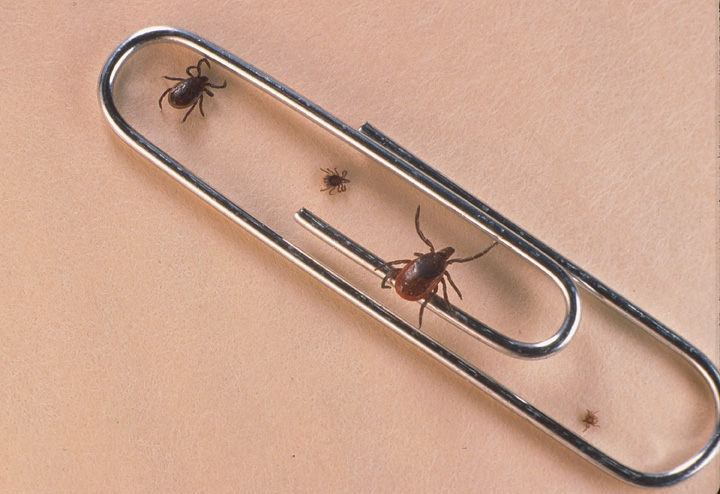WINNIPEG – Winnipeg City Hall will be lit in green Thursday to help raise awareness of Lyme disease among Manitobans.

The symbolic gesture will come in the middle of Lyme Disease Awareness Month and a day after Manitoba Health issued a news release urging people in the province to protect themselves from ticks, the small, blood-sucking insects that carry and spread the sometimes fatal disease.
READ MORE: Tick threat in Winnipeg on the rise
Jan Cmela, a Winnipegger who has Lyme disease, urges people to check themselves for ticks whenever they spend time outdoors and to be aware of the symptoms.
“It has to be caught early,” she said.
Winnipeg was recently put on the map that shows areas where deer ticks with Lyme disease are found. The ticks are most common along the edge of forests and in areas with thick, woody shrubs and other vegetation.
The province warns that current risk areas for Lyme-carrying ticks in Manitoba are:
- the Winnipeg area in isolated pockets along the Red, Seine and Assiniboine river corridors;
- the southeast corner of the province, where the border meets Ontario and Minnesota, which extends north into Moose Lake Provincial Park and west to Sprague;
- the Pembina Valley region, from the U.S. border to the rural municipality of South Norfolk in the north and Killarney in the west, plus portions of the valley escarpment near Morden and Miami;
- the Assiniboine corridor, which extends west from Beaudry Provincial Park along the Assiniboine River, and some of its tributaries, such as the Souris River, as far as Spruce Woods Provincial Park and the Brandon Hills Wildlife Management Area;
- the St. Malo region, including St. Malo Provincial Park and Vita and Arbakka near the U.S. border, north through Rodeau River, Kleefeld and St. Malo;
- the Richer/Ste. Genevieve area, east of Winnipeg along the Agassiz and Sandilands provincial forests, extending south to Ste. Anne and north into Birds Hill Provincial Park;
- St. Ambroise Provincial Park along the southeast shore of Lake Manitoba; and
- Patricia Beach Provincial Park along the southeast shore of Lake Winnipeg.
Blacklegged ticks can be found in other parts of Manitoba, but the risk is relatively low outside the areas identified above, Manitoba Health said.
READ MORE: Ticks and Lyme disease: what you need to know
The blood-borne illness can be fatal if it goes unnoticed, but can be successfully treated with antibiotics if caught early. Symptoms of Lyme disease start about three days to a month after a tick bite. They can but don’t always include an expanding rash at the bite site that later fades, a headache, stiff neck, muscle aches or fatigue, fever, chills and swollen lymph nodes. It has in the past been misdiagnosed as diseases such as fibromyalgia and chronic fatigue syndrome.
- ‘She gets to be 10’: Ontario child’s heart donated to girl the same age
- Bird flu risk to humans an ‘enormous concern,’ WHO says. Here’s what to know
- Shoppers faces proposed class action over claims company is ‘abusive’ to pharmacists
- ‘Bacterial vampirism’: Deadly pathogens attracted to human blood, study finds
The risk of tick exposure can be minimized by:
- applying tick repellent on exposed skin and clothing;
- inspecting children, pets and others after spending time outdoors;
- removing ticks as soon as possible from people and pets;
- staying to the centre of walking trails;
- wearing long pants and long-sleeved shirts; and
- keeping grass and shrubs around homes cut short to create drier environments that are less sutiable for blacklegged tick survival.
Cmela said in addition to knowing the symptoms and checking for ticks, people who suspect they have Lyme disease or who have had a tick may have to push their doctors for treatment, as the disease is relatively new.
When removing ticks, follow the procedure recommended by the Canadian Lyme Disease Foundation to minimize risk, she said — but she warned that people may not even know they had a tick.
“They are as small as a poppyseed,” she said. “You have to be aware of the symptoms.”
If you have a tick, keep it, Cmela said, and if symptoms arise, insist the tick be tested for Lyme, as it is more difficult to detect in humans than in ticks.
“Push your doctor,” said said, including insisting on a course of antibiotics if you suspect you have been exposed to Lyme disease.
There have been 114 confirmed or probable cases of Lyme disease reported to Manitoba Health since it became a reportable disease in 2009. There were 34 cases reported in 2014.
If you suspect you have Lyme disease, see your doctor.





Comments